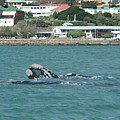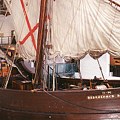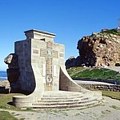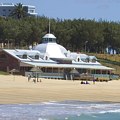- Home
- Community
- Business
-
Tourism
- Towns
- Accommodation
- Attractions
- Activities
- Gallery
- Maps
- Outings
- Pet-friendly accommodation
- S.A. Distance Chart
- Tide Chart
- Tourism Offices
- About Us
- Products
- User Menu
In a town where the constant, rhythmic hush of the sea is the undertone that fills the day, the Mossel Bay promise is effortlessly kept. And whilst the sea is without a doubt one of the greatest attractions of Mossel Bay – it’s only one of them.
Wilderness areas, natural beauty, adventures, a well developed infrastructure with modern schooling, sports and medical facilities, a vibrant business and industrial
community, cultural attractions – and, of course, miles and miles of clean, white beaches. Who, indeed, would want to hurry – or worry – in Mossel Bay?
The wide sweep of shoreline against a background of dramatic, rugged mountains - Mossel Bay is one of the biggest attractions on the Garden Route. And while you're here, here are some of the things you're going to enjoy:
Whale Watching
 Mossel Bay lies almost in the centre of the Whale Route which stretches from the West Coast to East London in the East. It seems Southern Right whales agree: Mossel Bay has the perfect combination of depth and shelter for romance - and for safe and easy calving. Every year from about May to October whales visit the Bay, often in schools of 10 or more, mostly near Little Brak River. They seek out the safe and calm waters of the Bay during their calving season. The whale cow usually swims around alone until her calf is born, but is sometimes accompanied by one or more female whales believed to act as midwives. They play together and stay in the Bay for about three months for the calves to grow stronger. The males will join the females only after the calves have been weaned, when mating takes place, before they all return to the Antarctic.
Mossel Bay lies almost in the centre of the Whale Route which stretches from the West Coast to East London in the East. It seems Southern Right whales agree: Mossel Bay has the perfect combination of depth and shelter for romance - and for safe and easy calving. Every year from about May to October whales visit the Bay, often in schools of 10 or more, mostly near Little Brak River. They seek out the safe and calm waters of the Bay during their calving season. The whale cow usually swims around alone until her calf is born, but is sometimes accompanied by one or more female whales believed to act as midwives. They play together and stay in the Bay for about three months for the calves to grow stronger. The males will join the females only after the calves have been weaned, when mating takes place, before they all return to the Antarctic.
On a good whale watching day (during whale season - May to October), you can see the whales from almost any elevated position on the shore. Here are some of our favourites:
Seal Island
This island is about 2km from the Harbour and is about l00m long and 50m wide. The Sea Fisheries Department controls the Island and count the seal population from the air at regular intervals. At present there are some 4500 to 5000 seals on the island. No culling is done on this Island any more as the population remains fairly stable due to adult seals moving away to join new colonies.
Usual movement is to the West Coast where there is plentiful food. Porpoises are regularly seen in the Bay when they move in long schools past the Point, in mid-afternoon.
Mossel Bay Arts and Crafts Route
The greater Mossel Bay abound in specialty shops and venues where arts, crafts and a wide variety of exclusive items can be obtained. Follow the Mossel Bay Arts and Craft Route and return home with wonderful gifts for friends and family, or a great memoir of an unforgettable holiday! Start the route inside the Bartolomeu Dias Museum Complex at the museum shop.
Historical Buildings in Mossel Bay
The age and history of buildings in South Africa cannot and should not be compared to the centuries old buildings in Europe. Southern Africa was the NEW WORLD discovered by the Seafarers and Explorers of the 15th Century. It is against this background that the visitor should look at the age of buildings and towns in South Africa. Mossel Bay is a fairly old town on the South African calendar, and there are many old and interesting buildings here. Many of the old stone buildings were demolished during the 50s and 60s, but the remaining buildings are jealously guarded by the Heritage Society.
The Maritime Museum - Old Roller Mill and Saw Mill Building (1901)
 The building was originally erected in 1901 to serve as a grain and sawmill. It was adapted to serve as a unique Maritime Museum and houses the impressive life-size replica of Bartolomeu Dias's caravel, the ship in which he sailed into Mossel Bay in the year 1488. It also displays ship models of a bygone era, route maps to the East and exploration of the Dark Continent in general. Visitors are allowed onto the caravel for a small donation and guided tours are available by prior arrangement. Tel: 27 (0)44 6911067
The building was originally erected in 1901 to serve as a grain and sawmill. It was adapted to serve as a unique Maritime Museum and houses the impressive life-size replica of Bartolomeu Dias's caravel, the ship in which he sailed into Mossel Bay in the year 1488. It also displays ship models of a bygone era, route maps to the East and exploration of the Dark Continent in general. Visitors are allowed onto the caravel for a small donation and guided tours are available by prior arrangement. Tel: 27 (0)44 6911067
The Ochre Barn
Adjacent to the Museum Complex is the not-to-be-missed Ochre Barn - the building dating back from the early 18th century when it was first used as a warehouse, then a trading post and later owned by the "African Golden Ochre" Company, who exported ochre from Albertinia via Mossel Bay, to England. It currently houses hidden treasures such as antiques, shells, gemstones, handmade jewelery and exquisite diamonds, leather products and a definite highlight - the Model Ship Company - one of its kind, where replicas of early vessels are handcrafted with meticulous care by local craftsmen.
The Old Joinery - Montagu Street
This small double storey rose-coloured stone building is listed as a National Monument. It is believed to have been designed by Sir Herbert Baker and built in l898 as a Joinery Shop. It has been used as a Carpenter Shop, Antique Shop, Art Gallery and several other small business concerns. It now houses a leather goods shop.
The Post Office Tree and Seaman’s Boot Port Box
 This giant milkwood tree is estimated to be more than 800 years old and has been declared a National Monument. It is thought to have been underneath this milkwood tree where Pedro d'Ataide left a letter in 1500 in a seaman's boot (or under a stone) for passing ships. Today a replica of a seaman's boot serves as a postbox next to the tree and all letters posted there bear a special Post Tree postmark.
This giant milkwood tree is estimated to be more than 800 years old and has been declared a National Monument. It is thought to have been underneath this milkwood tree where Pedro d'Ataide left a letter in 1500 in a seaman's boot (or under a stone) for passing ships. Today a replica of a seaman's boot serves as a postbox next to the tree and all letters posted there bear a special Post Tree postmark.
This post box marks the site of the first "Post Office" on the African Sub-continent. A Portuguese Padrao, or stone cross, commemorating the padrao planted by Da Gama, was presented to the town in the early 60s, by the Portuguese Government. This Padrao was later moved to the rocky outcrop above Munro's Hoek, clearly visible from the Tree.
The War Memorial
This Memorial stands on the rock formation known as Frog Rock. It was erected in memory of the men from the town and district who died during the two World Wars, and the wars in Korea and Angola. Stand just outside the wall behind the Memorial and look up towards the left of the Cave. A clear image of Gladstone's face in profile can be seen as formed by the rock edge.
Bat's Cave - Also called Lighthouse Cave, St Blaize Cave, Khoi-San Cave
This name was given during the first occupation of the area when thousands of bats still lived there. The roof of the Cave is over 10m high, it is 12m deep and 22 metres wide at its mouth. It is certain that the Khoi, or Strandlopers, and San lived in this Cave, at different times, in past centuries. During an archaeological dig in the 1880's an old midden consisting mainly of sedimented shells was uncovered, indicating that early dwellers of the Cave may have lived largely on a diet of shellfish. It was also recorded in a book in 1888 that after removing some two metres of bat guano and dirt, some artifacts were discovered including a well preserved vase of Eastern origin. Looking at the cave from war memorial, from the left, an image of Gladstone's profile can be seen. Some years ago an application for an Art Gallery to be built in the Cave was sensibly turned down by the Council. There is once again a move to "make a better use" of the Cave for the sake of Tourism.
The use of light beacons or fires to guide ships dates back to 600 BC. Fires were used on Robben Island before Greenpoint Lighthouse was erected in 1824. St Blaize lighthouse was commissioned in l864. Today all lighthouses along the coasts of South Africa are fully automated, except for only two manned lighthouses, of which St Blaize is one, still operating at dangerous spots.
St Blaize Hiking Trail - Also known as Rotary Walk
This hiking trail of l3 km starts at the Cave runs around the back of the promontory, hugging the edges of the high cliffs and ends at Dana Bay. It is an easy walk through beautiful gorges with lovely fynbos and breathtaking sea and cliff views. Care should be taken as the path runs close to the cliff edges in places.
Oyster Beds
Mossel Bay used to be famous for its oysters, but is now better known for its tasty local soles. A great many oysters are still harvested in and around the Bay by a few traders with concessions which are very strictly controlled. Private divers may only remove 25 oysters each per day. There are good beds on the rocks at Hartenbos, Little Brak, Reebok and Tergniet areas as well as in Vleesbaai and Fransmanshoek.
The Santos Pavilion.
 This beautiful Pavilion is one of only two beach pavilions still in use from Colonial times. The other one is the famous Royal Pavilion in Brighton. A local architect of the town travelled to Brighton to get ideas and it was then built in l9l6 by WJR Swart. During the 1920's and 1930's the Pavilion was a social meeting place for the townsfolk who regularly gathered there to listen to the Band and to exchange news and gossip. In l925 the then Prince of Wales visited the Pavilion during his visit to South Africa. In l979 a fire destroyed the roof and woodwork of the building and the remains was nearly demolished. It was later taken over by a private company who restored it and was granted a 30 year lease in 1986.
This beautiful Pavilion is one of only two beach pavilions still in use from Colonial times. The other one is the famous Royal Pavilion in Brighton. A local architect of the town travelled to Brighton to get ideas and it was then built in l9l6 by WJR Swart. During the 1920's and 1930's the Pavilion was a social meeting place for the townsfolk who regularly gathered there to listen to the Band and to exchange news and gossip. In l925 the then Prince of Wales visited the Pavilion during his visit to South Africa. In l979 a fire destroyed the roof and woodwork of the building and the remains was nearly demolished. It was later taken over by a private company who restored it and was granted a 30 year lease in 1986.
Just Outside Of Mossel Bay
Take a drive to Great Brak River (Hough's Herbal garden and many art galleries); the historic mission station at Friemersheim in the foothills of the Outeniqua Mountains or the Wolwedans Dam...